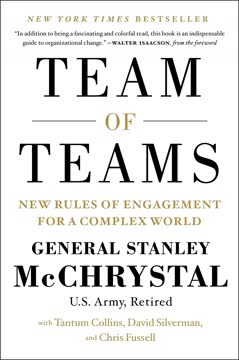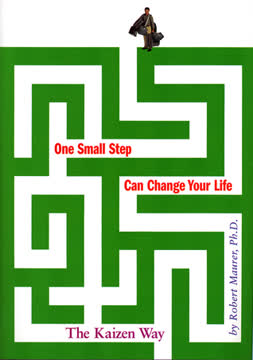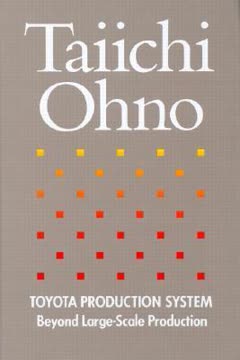Key Takeaways
1. Toyota's success stems from its unique improvement kata and coaching kata
Toyota's success is not due to sudden innovation or having airtight plans, but about the ability to execute more effectively in the face of unforeseeable obstacles and difficulties.
The improvement kata is Toyota's systematic routine for continuous improvement and adaptation. It involves:
- Grasping the current condition
- Defining a measurable target condition
- Moving toward that target through rapid PDCA cycles
The coaching kata is how Toyota teaches and reinforces the improvement kata throughout the organization. Key elements include:
- Mentor-mentee dialogues
- Learning by doing on real processes
- Frequent, short coaching cycles using the "five questions"
These two kata form the foundation of Toyota's management system and explain its ability to:
- Continuously improve quality and productivity
- Adapt quickly to changing conditions
- Develop capable problem-solvers at all levels
2. The improvement kata is a scientific approach to continuous improvement
The scientific method consists of formulating hypotheses and then testing them with information obtained from direct observation.
The improvement kata follows the scientific method:
- Define a target condition (hypothesis)
- Take steps toward it through experiments (PDCA cycles)
- Learn from both successes and failures
Key principles:
- Go and see the actual condition firsthand
- Use facts and data, not opinions
- Change only one thing at a time to see cause and effect
- Expect and learn from problems/obstacles
Benefits of this approach:
- Develops deeper understanding of processes
- Reveals hidden problems and improvement opportunities
- Builds problem-solving capabilities in people
- Leads to more effective and sustainable improvements
3. Target conditions drive improvement and reveal obstacles
A target condition works like a pair of eyeglasses that helps you focus and see what you need to do.
Target conditions:
- Describe a desired future state for a process
- Are more specific than high-level goals or KPIs
- Have a clear achievable-by date (usually 1-3 months out)
Elements of a good target condition:
- Process steps, sequence, and times
- Number of operators, shifts, equipment
- Key process metrics (e.g. cycle time, changeover time)
- Where 1x1 flow or pull systems will be used
Benefits:
- Provides clear direction for improvement efforts
- Reveals obstacles preventing achievement of the desired state
- Allows frequent checking of actual vs. target condition
- Motivates creative problem-solving
4. PDCA cycles are the engine of learning and adaptation
Every step = a PDCA cycle
Plan-Do-Check-Act (PDCA) cycles:
- Are how Toyota experiments and learns
- Should be done in rapid succession (hours/days, not weeks/months)
- Focus on one small change at a time
Key principles:
- Expect the unexpected - the path to the target condition is unclear
- Learn from both successes and failures
- Adjust based on what you learn with each cycle
Benefits:
- Allows quick detection and correction of problems
- Develops deeper understanding of processes
- Builds problem-solving capabilities in people
- Leads to more effective and sustainable improvements
5. Leaders are teachers who develop people's capabilities
The primary task of Toyota's managers and leaders does not revolve around improvement per se, but around increasing the improvement capability of people.
Leader as teacher:
- Spends 50%+ of time developing people's capabilities
- Teaches through mentor-mentee dialogues, not lectures
- Focuses on how people approach problems, not just results
Key mindsets:
- Problems are opportunities for learning and development
- The organization's strength lies in its people's capabilities
- Teaching is part of every leader's job, not just HR
Benefits:
- Develops problem-solving capabilities throughout the organization
- Creates a culture of continuous learning and improvement
- Ensures sustainability of the improvement system
6. The coaching kata uses mentor-mentee dialogues to teach the improvement kata
The mentor guides the mentee in applying the improvement kata through a back-and-forth dialogue over a period of time, which has sometimes been compared to a game of catch.
Key elements of the coaching kata:
- Frequent, short (15-minute) coaching cycles
- Use of the "five questions" to structure dialogues
- Focus on one target condition/mentee at a time
The five questions:
- What is the target condition?
- What is the actual condition now?
- What obstacles prevent reaching the target condition? Which one are you addressing now?
- What is your next step? (Start of next PDCA cycle)
- When can we go and see what we have learned from taking that step?
Benefits:
- Provides structure for teaching the improvement kata
- Allows mentor to understand mentee's thinking and provide appropriate guidance
- Reinforces scientific thinking and PDCA
7. Developing new organizational behaviors requires systematic practice
We learn habits, automatic reactions, by repeatedly practicing behaviors.
Key principles for behavior change:
- Learning by doing on real processes, not just classroom training
- Frequent, short practice sessions (daily if possible)
- Clear target conditions for both processes and coaching
- Regular reflection and adjustment of the teaching approach
Stages of skill development:
- Awareness (basic understanding)
- Application (can carry out the improvement kata)
- Teaching (can coach others in the improvement kata)
Common obstacles:
- Reverting to old habits (e.g. making action item lists)
- Discomfort with uncertainty and iteration
- Viewing the effort as "just another project"
8. Improvement kata thinking applies at all levels of the organization
The improvement kata finds application at all levels.
Applications beyond the shop floor:
- Product development
- Administrative processes
- Strategy deployment
- Organizational change efforts
Key principles remain the same:
- Grasp the current condition
- Define a clear target condition
- Move toward it through rapid PDCA cycles
- Use coach-mentee dialogues to develop capabilities
Benefits:
- Creates alignment throughout the organization
- Develops problem-solving capabilities at all levels
- Improves adaptability to changing conditions
9. Metrics and incentives alone cannot drive continuous improvement
There is no combination of outcome metrics and incentive systems that by themselves will generate Toyota-style continuous improvement and adaptation.
Limitations of traditional approaches:
- Focus on outcomes obscures process-level realities
- Create pressure to "hit the numbers" rather than improve
- Don't develop problem-solving capabilities in people
Toyota's approach:
- Uses process-level metrics to guide improvement efforts
- Focuses on developing capabilities, not just achieving targets
- Sees problems as opportunities for learning and improvement
Key mindset shifts:
- From "manage by results" to "manage by means"
- From "implement solutions" to "develop problem-solving capabilities"
- From "avoid problems" to "surface and solve problems"
10. Cultural change starts with senior leadership practicing new behaviors
If the top does not change behavior and lead, then the organization will not change either.
Key steps for leaders:
- Learn and practice the improvement kata themselves
- Establish an "advance group" to develop internal expertise
- Create a plan for spreading the kata throughout the organization
- Coach and mentor others in the new behaviors
Common pitfalls to avoid:
- Delegating the change effort to a "lean team"
- Relying solely on classroom training or consultants
- Expecting quick results without sustained effort
Benefits of leader-led change:
- Demonstrates commitment to the new approach
- Develops deep understanding of what's involved
- Creates alignment throughout the organization
- Builds momentum for sustained culture change
Last updated:
FAQ
What's Toyota Kata about?
- Focus on Management Practices: Toyota Kata by Mike Rother delves into Toyota's unique management practices that foster continuous improvement and adaptability.
- Improvement and Coaching Kata: It introduces the Improvement Kata for systematic problem-solving and the Coaching Kata for teaching these practices.
- Long-term Success Philosophy: The book emphasizes Toyota's management philosophy, which prioritizes continuous improvement over merely achieving financial targets.
Why should I read Toyota Kata?
- Transformative Insights: Gain a deep understanding of Toyota's management methods applicable to any organization seeking process improvement.
- Practical Framework: Offers a framework for developing a culture of continuous improvement, relevant for managers and executives.
- Real-world Applications: Concepts are backed by real-world examples, making them actionable for implementing change.
What are the key takeaways of Toyota Kata?
- Management by Means: Focus on processes rather than results for better long-term outcomes.
- Target Conditions: Establish clear target conditions to guide improvement efforts and align team objectives.
- Continuous Learning: Emphasizes learning through experimentation and adapting based on real-time observations.
What is the Improvement Kata in Toyota Kata?
- Systematic Approach: A structured routine guiding teams in setting target conditions and working towards them through problem-solving.
- Four Steps: Involves understanding the current condition, defining the target condition, identifying obstacles, and experimenting to overcome them.
- Focus on Learning: Encourages continuous learning and adaptation, allowing organizations to respond effectively to changes.
What is the Coaching Kata in Toyota Kata?
- Teaching Improvement Practices: A method for leaders to teach the Improvement Kata, ensuring organizational understanding and application.
- Role of Leaders: Leaders act as coaches, guiding teams through the Improvement Kata process to develop problem-solving skills.
- Building Capability: Fosters a culture of improvement by empowering employees to take ownership and seek better ways to achieve goals.
How does Toyota Kata define a target condition?
- Desired Future State: A target condition is a clear description of a desired future state for a process, guiding improvement efforts.
- Focus on Process: Emphasizes operational aspects rather than outcome metrics, helping teams understand their focus areas.
- Challenging Yet Achievable: Target conditions should push teams to stretch capabilities while remaining realistic.
What is the significance of PDCA in Toyota Kata?
- Plan-Do-Check-Act Cycle: PDCA is a fundamental part of the Improvement Kata, representing a cycle of experimentation and learning.
- Iterative Learning: Encourages testing hypotheses, observing outcomes, and adjusting approaches based on learning.
- Adaptability: Allows organizations to adapt to changing conditions, ensuring responsiveness and effectiveness.
How does Toyota Kata address problem-solving?
- Focus on Obstacles: Emphasizes understanding and eliminating obstacles as a normal part of the improvement process.
- Learning from Failure: Encourages viewing problems as opportunities for learning and improvement.
- Systematic Approach: Uses the Improvement Kata to guide teams in identifying root causes and developing solutions.
What are the five questions in the Improvement Kata?
- Target Condition: "What is the target condition?" helps define the specific goal the team is striving to achieve.
- Current Condition: "What is the actual condition now?" encourages assessing the current state and identifying gaps.
- Obstacles: "What obstacles are now preventing you from reaching the target condition?" pinpoints challenges to address.
- Next Step: "What is your next step?" focuses on immediate actions to move closer to the target condition.
- Learning Check: "When can we go and see what we have learned from taking that step?" emphasizes reflection and learning.
How does Toyota Kata promote a culture of continuous improvement?
- Behavioral Routines: Instills Improvement and Coaching Katas to develop consistent routines prioritizing continuous improvement.
- Empowerment: Encourages employees to identify problems and propose solutions, fostering ownership and accountability.
- Structured Learning: Ensures ongoing and systematic learning, helping organizations remain agile and responsive.
What challenges might organizations face when implementing Toyota Kata?
- Cultural Resistance: Resistance to changing established practices and mindsets may occur, requiring strong leadership.
- Training and Development: Significant efforts may be needed to ensure all employees understand and apply the Katas.
- Sustaining Momentum: Maintaining enthusiasm for continuous improvement can be challenging, needing regular reflection and adaptation.
What are the best quotes from Toyota Kata and what do they mean?
- "Problems are jewels.": Problems are valuable opportunities for learning and improvement, not obstacles to avoid.
- "The penny finally dropped and now I understand it.": Illustrates the realization of understanding Toyota's deeper principles.
- "Do or do not. There is no try.": Emphasizes commitment to improvement through decisive action rather than half-hearted attempts.
Review Summary
Toyota Kata receives high praise for its insights into Toyota's continuous improvement culture. Readers appreciate the focus on changing mindsets rather than just implementing tools. The book explains two key concepts: the Improvement Kata for problem-solving and the Coaching Kata for developing people. Many find it applicable beyond manufacturing. Some criticize the repetitive content and manufacturing focus. Overall, it's considered valuable for leaders seeking to create a culture of ongoing adaptation and improvement in their organizations.
Similar Books










Download PDF
Download EPUB
.epub digital book format is ideal for reading ebooks on phones, tablets, and e-readers.




